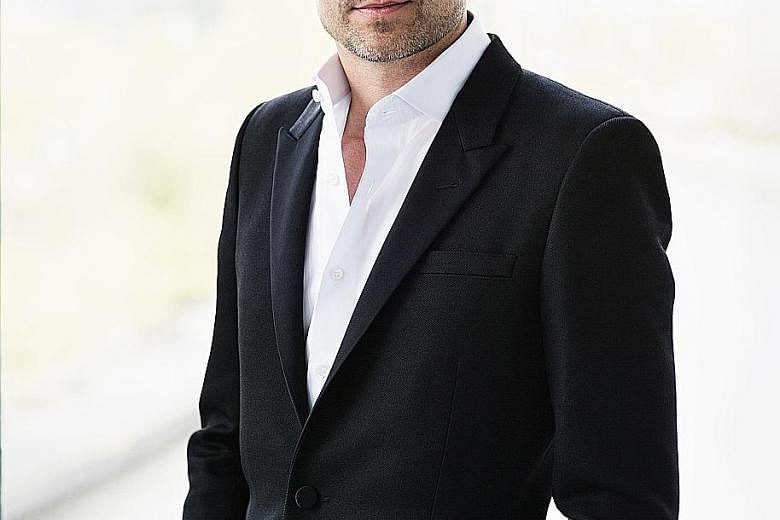Mr Ole Scheeren steps into a bright showflat on the 42nd floor of a luxury condominium overlooking Kampong Glam.
The world-famous architect makes his way to a window and half-turns to face it. He pauses, savouring the view of old shophouses and office buildings below with quiet satisfaction.
The silhouette of the architect surveying his creation is a recurring image during his hour-long tour of the Duo skyscrapers in Fraser Street that he designed.
The two swanky, Tetris-like buildings which contain offices, shops, luxury flats and a hotel, officially opened a fortnight ago.
These are lofty, eye-catching creations. But 47-year-old Scheeren, who is known for his unusual designs, says designing Duo - which has a gross development value of around $4 billion - has also been about creating a "civic nucleus" with spaces the public can reclaim as their own.
"The reason my buildings may be different is not because I want them to look different, but because they do something different," he says, defending his vision in an industry where high-profile architects have been lambasted for neglecting local context in an attempt to be unique.
He adds: "I'm interested in 'what does something do, how do we create with big flexible floor play..."
"It's not about making random silhouettes," says the German-born architect who, with OMA, designed The Interlace in Depot Road. The condominium comprises 31 blocks of apartments stacked like Jenga blocks .
Importantly, Duo is a fenceless community: Lobbies have been lifted to a higher level and there is a "24-hour permeable" plaza on the ground level that the public can pass through.
The 1.73 million sq ft development won a silver award in the Best Futura Project category at the 2012 Mipim Asia Awards, which recognise excellence and innovation in real estate development.
Duo Tower contains 20 storeys of office space as well as the five-star Andaz Singapore hotel. The Duo Galleria provides retail and lifestyle spaces, while Duo Residences houses 660 luxury apartment units - nearly all of which have been sold.
The story behind the two buildings, developed by M+S, a joint venture between Singapore and Malaysia, following a landmark pact between the two countries, is one Mr Scheeren has recited many times.
"It's about two countries coming together in a joint venture that is quite historic. It was important to symbolise that. The site before we started building here was what I would call a piece of no man's land," he adds, referring to the U-shaped plot between Parkview Square and The Gateway.
"It was really a piece of land that entirely disconnected, scattered things around it. And I think it exemplifies a problem with contemporary urbanism, when a city is built with essentially independent developments.
"Singapore has incredible vegetation, which, in a way, glues everything together... but if you look closely, there's often, I think, a complete disregard for context."
Among his iconic creations is the loop-shaped CCTV headquarters in Beijing which he designed with Dutch architecture firm OMA.
Then there is the 77-storey MahaNakhon in Bangkok - Thailand's tallest building. With a "pixellated" facade, it looks as though it is disintegrating while reconstructing itself skyward.
In November, he unveiled plans for a "sky forest" in Ho Chi Minh City. Other upcoming projects include high-rise residential developments in Vancouver and Frankfurt.
Several days ago, he released photos of the Guardian Art Center, which he designed, located on the edge of Beijing's Forbidden City.
He likes to think of his style as "performative" rather than decorative, calling his buildings "urban actors" that "inter-act" with the cityscape around them.
"Movement has something to do with freedom," says the architect, who appears more at ease during the building tour than when sitting down for the interview.
"I think, to be able to shift perspective and your view on things has something to do with freedom and it also has something to do with a continuous search, maybe."
Being in Asia at a time of rapid modernisation, says Mr Scheeren, has made him see "possibility in everything".
There have also been limitations.
"Singapore is a merciless world of efficiency in many ways. And as you work for the context of commercial development, you are very hard-pressed to fulfil expectations of efficiency.
"Every square centimetre of space has to be attributable to commercial value... But that has also become one of the predominant realities of architecture."
However, he says Duo and The Interlace have managed to go beyond the status quo.
The Interlace, which opened in 2013, has greenery that covers 112 per cent of the original site area. In 2015, it was declared Building of the Year at the World Architecture Festival.
While he does not have any projects in the pipeline for Singapore right now, Mr Scheeren says he is open to doing more in the future.
Asked about his thoughts on the new trend of timber skyscrapers, he says: "One very surprising aspect of wood is that it is much more fire-resistant than steel... Wood, as it chars, develops its own insulation against the heat, it is simply much more resistant or stable in a heated condition than steel - once steel reaches its melting point, it's over."
"We are looking currently at a few possibilities in how we can use wood not as a finish material, but as a structural material," he says, although he could not reveal details.
Many architects are obsessed about leaving their mark, but Mr Scheeren says he is more interested in the memories and meaning his buildings generate for the people around them.
"The question is, what do the things I create leave behind for the environment. That is maybe is a legacy - but it's not a persona."


